Triathlon Training Essentials: Swim, Bike, Run Like a Pro
Triathlons demand mastery of three distinct disciplines—swim, bike, and run—each requiring unique skills, training approaches, and gear. Whether you’re tackling your first sprint triathlon or aiming for an ironman training plan, this guide breaks down expert strategies to help you excel in each segment, along with race-day strategies and triathlon gear recommendations to ensure a strong finish.
1. Swim: Master the Open Water
The swim sets the tone for your race. Even strong pool swimmers must adapt to open-water challenges like choppy waves, drafting, and sighting.
Training Focus: Technique and Endurance
- Drill Work (2–3 sessions/week): Prioritize catch-up drills, single-arm freestyle, and flip turns to improve stroke efficiency.
- Open-Water Practice: At least 1 session/week to acclimate to cold water, navigate buoys, and practice sighting (lifting your head every 6–8 strokes to check direction).
- Long Sets: 4x500m at race pace with 30-second rests to build stamina for the ironman-distance 2.4-mile swim.
Key Technique Tips:
- Body Position: Keep your hips high to reduce drag—imagine a straight line from head to heels.
- Breathing Rhythm: Bilateral breathing (every 3 strokes) ensures balance and reduces neck strain.
Triathlon Gear for Swimming:
- Wetsuit (for cold water): A buoyant, front-zipper model like the Zone3 Vanquish wetsuit lifts your legs and chest, improving streamline.
- Swim Cap and Goggles: Use a silicone cap for speed and mirrored goggles (e.g., Speedo Vanquisher) to cut glare in open water.
- Sports Watch with Swim Mode: Track lap count, stroke rate, and distance with EZON’s multisport watch, which auto-detects swim sessions and syncs data to training apps.
2. Bike: Power, Pacing, and Efficiency
The bike segment is where you can make up time, but poor pacing can cripple your run. Focus on sustainable power and aerodynamics.
Training Focus: Power Output and Terrain Adaptation
- Sweet Spot Training (2–3 sessions/week): 88–94% of FTP (functional threshold power) for 3x20-minute efforts to improve sustainable race pace.
- Hill Repeats and Descents: Practice climbing at high cadence (80–90 RPM) and descending with controlled aerodynamics to build leg strength and confidence.
- Brick Workouts: Pair 90-minute rides with 30-minute runs to acclimate legs to “jelly legs” and refine transitions.
Pacing Strategy:
- Ironman Bike Pace: Aim for 70–75% of FTP to save energy for the marathon. Use a GPS bike computer or sports watch to monitor wattage/heart rate and avoid surges.
- Drafting (Legal in Sprint/Olympic, Illegal in Ironman): In draft-legal races, stay 7m back to reduce wind resistance; in ironman, maintain a 12m gap to avoid penalties.
Triathlon Gear for Cycling:
- Aerodynamic Bike: A tri-specific bike (e.g., Cervélo P 系列) with aero bars reduces drag—test fit to ensure comfort for 112-mile rides.
- Clip-In Pedals: Shimano SPD-SL or Look Keo for efficient power transfer; practice clipping in/out to avoid race-day fumbles.
- Wearable Tech: EZON’s GPS series tracks cadence, speed, and elevation, with 40+ hours of battery life for ironman-distance rides.
3. Run: Master the Marathon After the Bike
The run is a mental and physical test. Train your legs to run efficiently on fatigued muscles.
Training Focus: Brick Runs and Pace Control
- Brick Runs (2–3 sessions/week): 1–2 hours on the bike followed by 30–60 minutes of running, starting at a pace 10–15 seconds slower than your standalone half-marathon pace.
- Tempo Runs: 4x15 minutes at ironman marathon pace (e.g., 8:30/mile for a 3:45 marathon) to build familiarity with the effort.
- Strength Work: Lunges, step-ups, and calf raises to strengthen stabilizer muscles and reduce injury risk.
Race-Day Run Strategy:
- Negative Splits: Start 5–10 seconds slower per mile than goal pace, gradually increasing speed after 10K if feeling strong.
- Aid Stations: Walk through aid stations to drink/eat safely—spilling fluids costs more time than a 10-second walk.
Triathlon Gear for Running:
- Lightweight Running Shoes: Models like the Nike Vaporfly or Saucony Endorphin Speed for a responsive stride; break them in during brick workouts to avoid blisters.
- Race Belt: A stretchy belt (e.g., FlipBelt) to carry gels/salt tabs without bouncing.
- Heart Rate Monitor: EZON’s heart rate series ensures accurate effort tracking, even when legs feel heavy—aim to keep heart rate 5–10 BPM below your standalone running max.
4. Transition Training: The Fourth Discipline
Smooth transitions can save 2–5 minutes. Practice these critical steps:
Swim to Bike
- Wetsuit Removal: Unzip early, roll it down to your waist while running to T1, then sit to peel it off from the ankles up (use body glide on ankles for speed).
- Bike Gear Prep: Pre-clip shoes to pedals and lay out sunglasses/helmet for quick access.
Bike to Run
- Sockless Transition (Optional): Wear breathable running shoes and skip socks to save time (test for blisters in training).
- Heart Rate Reset: Walk 20 seconds out of T2 to steady your heart rate before settling into run pace.
5. Race-Day Strategies for Success
Nutrition and Hydration
- Swim: Hydrate with electrolytes 30 minutes prior; avoid eating right before to prevent nausea.
- Bike: Consume 30–60g carbs/hour (gels, bars, or sports drink) and 500–750ml fluids/hour—practice your plan in training to avoid gut issues.
- Run: Take a gel every 45 minutes and sip water at aid stations—overhydration is as dangerous as dehydration.
Pacing and Mental Toughness
- Split Goals: Break the race into segments (e.g., “Just focus on the first 10K run”), using a sports watch to hit micro-goals.
- Embrace Discomfort: Repeat a mantra (e.g., “Smooth and steady”) during tough moments—your training has prepared you for this.
6. Essential Triathlon Gear Checklist
| Category | Must-Haves | Nice-to-Haves |
|---|---|---|
| Swim | Wetsuit, goggles, swim cap | Paddles for strength, snorkel for sighting practice |
| Bike | Aero bike, clip-in pedals, cycling shoes | Power meter, aero bottle, tire repair kit |
| Run | Lightweight shoes, race belt | Compression socks, visor for sun protection |
| Transition | Towel, body glide, bike helmet | Quick-dry gear, transition bag |
| Tech | Multisport watch (EZON Sports Series) | Chest strap for heart rate, bike mount for watch |
Train Like a Pro with EZON’s Triathlon Gear
- Multisport Modes: Auto-detects swim, bike, run, and transitions, tracking metrics like stroke rate, cadence, and pace.
- Long Battery Life: 20+ hours in GPS mode for ironman-distance races, with rapid charging for brick workouts.
- Recovery Insights: Post-race HRV and sleep analysis to guide post-race recovery and future training plans.
Conquer the Triathlon Distance with Confidence
Triathlon success hinges on balancing specificity (discipline-focused training) with consistency (weekly volume). By mastering swim technique, pacing the bike, and embracing the run as a mental challenge, you’ll cross the finish line stronger than ever. Pair these strategies with reliable triathlon gear like EZON’s multisport watches, and you’ll have the tools to turn your ironman dreams into reality.
Remember, every swim stroke, pedal stroke, and stride is a step toward race-day excellence. Train with purpose, trust your preparation, and let the triathlon become a celebration of your endurance and grit.









